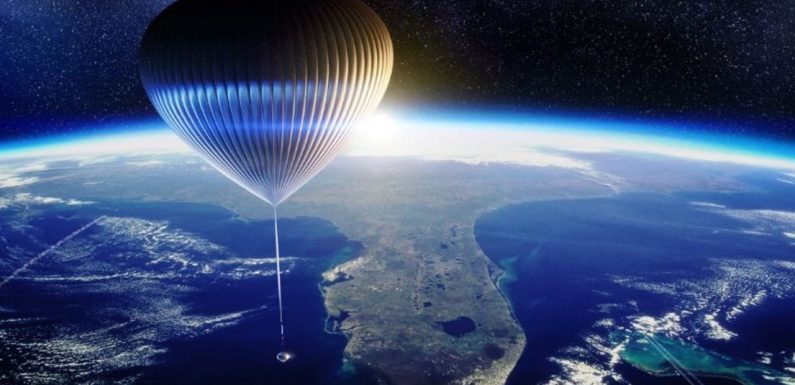
A space flight company has debuted a $165,000 package that brings travellers to the edge of our atmosphere on a space-age hot air balloon.
Florida-based firm Space Perspective aims to usher in a “new era in luxury travel experiences” with their groundbreaking — or air-breaking, if you will — tour aboard the Spaceship Neptune, a massive, hydrogen-supported balloon with a passenger capsule in tow that can float atop Earth’s atmosphere.
Space Perspective is sending civilians into space via hydrogen balloon. Picture: Space PerspectivesSource:Supplied
There, amateur astronauts can soak up the splendour of our home planet, thanks to panoramic windows and reclining seats.
If liquid courage is called for, a bar — and bathrooms, of course — are also built into the capsule’s compact design.
Individual and group reservations are now open for the inaugural 2024 launch, expected to take place at NASA’s Kennedy Space Center in Florida.
A seat aboard Spaceship Neptune costs $165,000 — a fraction of what some are paying to ride on other commercial spaceflight endeavours. Picture: Space PerspectivesSource:Supplied
Typical spaceflight places high demands on passengers and the planet as millions of kilograms of fuel are required for their turbulent launches.
Rather than bursting through the atmosphere at g-force speeds as rockets do, Spaceship Neptune offers a “radically gentle voyage” for guests aboard the eight-person capsules, designed to be tugged upward by a 200m-tall hydrogen-filled balloon — the most eco-friendly space travel option to date.
Reclining seats and a bar are some of the amenities aboard the Spaceship Neptune capsule. Picture: Space PerspectivesSource:Supplied
During a video news conference last year, Space Perspective husband-and-wife CEOs Jane Poynter and Taber MacCallum explained that Spaceship Neptune would spend about two hours reaching its maximum altitude of about 100,000 feet — 30.5km up — for a trip lasting about six hours. Proof of concept came on June 18 after a successful test flight from the Space Coast Spaceport in Titusville, Florida.
Spaceship Neptune’s passenger capsule will be tugged upward by a giant balloon filled with hydrogen. Picture: Space PerspectivesSource:Supplied
Despite the 1937 Hindenburg disaster — which saw the hydrogen-filled Zeppelin explode, killing 35 people — Space Perspective insists that hydrogen was their only option.
“Helium has become quite difficult to obtain,” Mr MacCallum said during a 2020 press presentation. “It’s used for a lot of medical practices and for launching rockets.”
In a statement to The Post, Space Perspective assured that their space balloons, made of Polyethylene with high tensile-strength material, are modelled after those that NASA and other government agencies have “flown for decades.”
Spaceship Neptune will lift off from NASA’s Kennedy Space Center in Florida and land in water, where passengers will be retrieved by boat. Picture: Space PerspectivesSource:Supplied
“Hydrogen is the gas of choice of balloonists around the world. There have been no recorded gas balloon flight failures caused by hydrogen going all the way back to the earliest flights in the 1700s,” the company said.
Hot air balloons today use either hydrogen or helium for initial lift-off, then are maintained by burning liquid propane — ergo “hot air.” Airships, such as blimps and modern Zeppelins, now generally use helium instead of hydrogen.
The space balloon is also “inherently safer than rocket flight,” the company said. There have been no recorded space balloon accidents involving humans, and “no failures” in “almost 100 flights” conducted with space balloon designs that match that of Space Perspective’s Spaceship Neptune.
Without the need for rocket propulsion and millions of pounds of jet fuel, Spaceship Neptune aims to be a more eco-conscious spacecraft. Picture: Space PerspectivesSource:Supplied
Space Perspective emerges at a time when many others rush to compete, including some of the world’s top air travel companies, such as Virgin Galactic and Boeing.
The competitive $US125,000 ($165,000) price is a fraction of the $37 million bid for a spot on the maiden voyage of Blue Origin, Jeff Bezos’ commercial space flight endeavour, set for lift-off July 20.
Meanwhile, Elon Musk’s SpaceX is preparing the “world’s first all-civilian” crew aboard its Falcon 9 rocket later this year, with funds raised from seats sold going to benefit St. Jude’s Children’s Research Hospital.
Tours to the International Space Station will commence at $72.6 million per tourist next year, and, in 2023, a SpaceX Starship led by Japanese billionaire Yusaku Maezawa — who put up an undisclosed amount of money for six seats on the spacecraft — is heading to the moon.
Space Perspective insists that theirs is a different sort of experience, combining innovation with the ease of luxury travel.
“We’re committed to fundamentally changing the way people have access to space — both to perform much-needed research to benefit life on Earth and to affect how we view and connect with our planet,” Ms Poynter said last year.
“That is really what this is all about,” she added. “Everybody should be able to see the Earth from space.”
This article originally appeared on the New York Post and was reproduced with permission
trending in travel
Source: Read Full Article
















